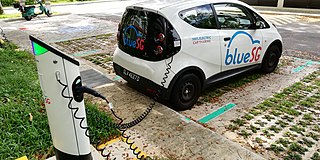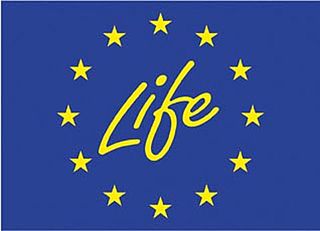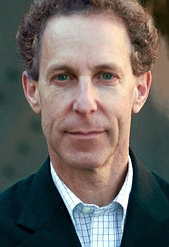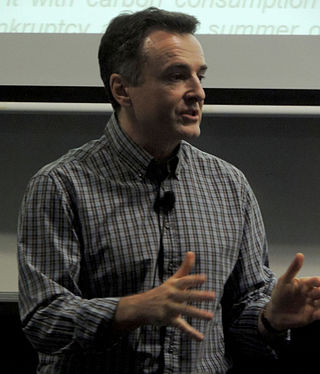Related Research Articles

Energy development is the field of activities focused on obtaining sources of energy from natural resources. These activities include the production of renewable, nuclear, and fossil fuel derived sources of energy, and for the recovery and reuse of energy that would otherwise be wasted. Energy conservation and efficiency measures reduce the demand for energy development, and can have benefits to society with improvements to environmental issues.
A green economy is an economy that aims at reducing environmental risks and ecological scarcities, and that aims for sustainable development without degrading the environment. It is closely related with ecological economics, but has a more politically applied focus. The 2011 UNEP Green Economy Report argues "that to be green, an economy must not only be efficient, but also fair. Fairness implies recognizing global and country level equity dimensions, particularly in assuring a Just Transition to an economy that is low-carbon, resource efficient, and socially inclusive."

Energy is sustainable if it "meets the needs of the present without compromising the ability of future generations to meet their own needs." Most definitions of sustainable energy include considerations of environmental aspects such as greenhouse gas emissions and social and economic aspects such as energy poverty. Renewable energy sources such as wind, hydroelectric power, solar, and geothermal energy are generally far more sustainable than fossil fuel sources. However, some renewable energy projects, such as the clearing of forests to produce biofuels, can cause severe environmental damage.

Environmental technology (envirotech) or green technology (greentech), also known as clean technology (cleantech), is the application of one or more of environmental science, green chemistry, environmental monitoring and electronic devices to monitor, model and conserve the natural environment and resources, and to curb the negative impacts of human involvement.

Clean technology, in short cleantech or climatetech, is any process, product, or service that reduces negative environmental impacts through significant energy efficiency improvements, the sustainable use of resources, or environmental protection activities. Clean technology includes a broad range of technology related to recycling, renewable energy, information technology, green transportation, electric motors, green chemistry, lighting, grey water, and more. Environmental finance is a method by which new clean technology projects can obtain financing through the generation of carbon credits. A project that is developed with concern for climate change mitigation is also known as a carbon project.
Cleaner production is a preventive, company-specific environmental protection initiative. It is intended to minimize waste and emissions and maximize product output. By analysing the flow of materials and energy in a company, one tries to identify options to minimize waste and emissions out of industrial processes through source reduction strategies. Improvements of organisation and technology help to reduce or suggest better choices in use of materials and energy, and to avoid waste, waste water generation, and gaseous emissions, and also waste heat and noise.
The New York State Energy Research and Development Authority (NYSERDA), established in 1975, is a New York State public-benefit corporation, located in Albany, New York, with regional offices in New York City, Buffalo, and West Valley.

Renewable energy commercialization involves the deployment of three generations of renewable energy technologies dating back more than 100 years. First-generation technologies, which are already mature and economically competitive, include biomass, hydroelectricity, geothermal power and heat. Second-generation technologies are market-ready and are being deployed at the present time; they include solar heating, photovoltaics, wind power, solar thermal power stations, and modern forms of bioenergy. Third-generation technologies require continued R&D efforts in order to make large contributions on a global scale and include advanced biomass gasification, hot-dry-rock geothermal power, and ocean energy. In 2019, nearly 75% of new installed electricity generation capacity used renewable energy and the International Energy Agency (IEA) has predicted that by 2025, renewable capacity will meet 35% of global power generation.

A green-collar worker is a worker who is employed in an environmental sector of the economy. Environmental green-collar workers satisfy the demand for green development. Generally, they implement environmentally conscious design, policy, and technology to improve conservation and sustainability. Formal environmental regulations as well as informal social expectations are pushing many firms to seek professionals with expertise with environmental, energy efficiency, and clean renewable energy issues. They often seek to make their output more sustainable, and thus more favorable to public opinion, governmental regulation, and the Earth's ecology.
Green jobs are, according to the United Nations Environment Program, "work in agricultural, manufacturing, research and development (R&D), administrative, and service activities that contribute(s) substantially to preserving or restoring environmental quality. Specifically, but not exclusively, this includes jobs that help to protect ecosystems and biodiversity; reduce energy, materials, and water consumption through high efficiency strategies; de-carbonize the economy; and minimize or altogether avoid generation of all forms of waste and pollution." The environmental sector has the dual benefit of mitigating environmental challenges as well as helping economic growth.
This page is an index of sustainability articles.
New Energy for America was a plan led by Barack Obama and Joe Biden beginning in 2008 to invest in renewable energy sources, reduce reliance on foreign oil, address global warming issues, and create jobs for Americans. The main objective of the New Energy for America plan was to implement clean energy sources in the United States to switch from nonrenewable resources to renewable resources. The plan led by the Obama Administration aimed to implement short-term solutions to provide immediate relief from pain at the pump, and mid- to- long-term solutions to provide a New Energy for America plan. The goals of the clean energy plan hoped to: invest in renewable technologies that will boost domestic manufacturing and increase homegrown energy, invest in training for workers of clean technologies, strengthen the middle class, and help the economy.

The LIFE programme is the European Union's funding instrument for the environment and climate action. The general objective of LIFE is to contribute to the implementation, updating and development of EU environmental and climate policy and legislation by co-financing projects with European added value. LIFE began in 1992 and to date there have been five phases of the programme. During this period, LIFE has co-financed some 4600 projects across the EU, with a total contribution of approximately 6.5 billion Euros to the protection of the environment and of climate. For the next phase of the programme (2021–2027) the European Commission proposed to raise the budget to 5.45 billion Euro.

The energy policy of the Obama administration was defined by an "all-of-the-above" approach which offered federal support for renewable energy deployment, increased domestic oil and gas extraction, and export of crude oil and natural gas. His presidency's first term was shaped by the failure of his signature climate legislation, the American Clean Energy and Security Act, to pass, and then climate and energy disasters including the Deepwater Horizon oil spill in 2010 and then Hurricane Sandy, which took place during the 2012 election. In his second term, Obama lifted the ban on crude oil exports and approved liquified natural gas exports; his planned regulatory approach to reducing greenhouse pollution in the electricity sector, the Clean Power Plan, was blocked by the U.S. Supreme Court.

Dan William Reicher is an American lawyer who was U.S. Assistant Secretary of Energy for Energy Efficiency and Renewable Energy at the U.S. Department of Energy (DOE) in the Clinton Administration. Reicher is currently executive director of the Steyer-Taylor Center for Energy Policy and Finance at Stanford University, a joint center of the Stanford Graduate School of Business and Stanford Law School, where he also holds faculty positions. Reicher joined Stanford in 2011 from Google, where he served since 2007 as Director of Climate Change and Energy Initiatives for the company's venture Google.org.

LA Cleantech Incubator (LACI) is the City of Los Angeles's official cleantech business incubator established to accelerate the commercialization of clean technology and job creation in the Los Angeles region. LACI's staff of entrepreneurs, market specialists, and researchers combined with its 60+ mentor/advisor network provide expert advice on a full range of issues facing early to growth stage companies, including CEO coaching, financial modeling, business development, IP, and more. The organization is run "by entrepreneurs, for entrepreneurs" and pursues public objectives by harnessing private methods and resources. In 2014, LACI was ranked by UBI Global as the Number 6 university-affiliated business incubator in the world out of 800+ incubators in 67 countries.

The World Resources Forum (WRF) is a non-profit organisation for sharing knowledge about the economic, political, social and environmental implications of global resource use. WRF promotes resource productivity among researchers, policymakers, business, NGOs and the public. In addition to organizing international and regional conferences, the WRF Secretariat coordinates multistakeholder dialogue projects, amongst others the Sustainable Recycling Initiative (SRI) as well as the H2020 projects Towards a World Forum on Raw Materials (FORAM), and CEWASTE. The WRF contributes to other EC-projects and projects with the German development organisation GiZ, UNEP and UNIDO.

John O'Brien is an English businessman and an expert advisor to Australian governments and the cleantech sector. He is a Partner with Deloitte Financial Advisory and leads the firm's Energy Transition and Decarbonisation work in Australia. He was formerly the managing director of Australian CleanTech which acted as the Australian representative for the Global CleanTech Cluster Association. He was also a non-executive director of Novarise Ltd, an ASX listed company which recycles polypropylene waste in China. O'Brien entered the Australian energy sector in the 1990s and worked for Origin Energy for nine years. He had previously worked in the Middle East, the United Kingdom and Canada where he held various oil and gas industry and consulting engineering roles. O'Brien lectured in leadership and entrepreneurship at the University of Adelaide and was a member of the Premier’s Climate Change Council in South Australia. He has been a member of the board of several CleanTech companies involved in wind farm development, biosensors and plastic recycling. He has served on the board of Renewables SA and as a member of the Clean Technology Innovation Program Committee at Innovation Australia. O'Brien has studied at Oxford, Trinity College in Dublin and the University of Adelaide from which he has received two engineering degrees and an MBA respectively.

Green industrial policy (GIP) is strategic government policy that attempts to accelerate the development and growth of green industries to transition towards a low-carbon economy. Green industrial policy is necessary because green industries such as renewable energy and low-carbon public transportation infrastructure face high costs and many risks in terms of the market economy. Therefore, they need support from the public sector in the form of industrial policy until they become commercially viable. Natural scientists warn that immediate action must occur to lower greenhouse gas emissions and mitigate the effects of climate change. Social scientists argue that the mitigation of climate change requires state intervention and governance reform. Thus, governments use GIP to address the economic, political, and environmental issues of climate change. GIP is conducive to sustainable economic, institutional, and technological transformation. It goes beyond the free market economic structure to address market failures and commitment problems that hinder sustainable investment. Effective GIP builds political support for carbon regulation, which is necessary to transition towards a low-carbon economy. Several governments use different types of GIP that lead to various outcomes. The Green Industry plays a pivotal role in creating a sustainable and environmentally responsible future; By prioritizing resource efficiency, renewable energy, and eco-friendly practices, this industry significantly benefits society and the planet at large.
The European Climate, Environment and Infrastructure Executive Agency (CINEA) is the European Commission agency which manages decarbonisation and sustainable growth. It is the successor organisation of the Innovation and Networks Executive Agency (INEA). Established on 15 February 2021, with a budget of €50 billion for the 2021-2027 period, it started work on 1 April 2021 in order to implement parts of certain EU programmes. The Agency will have a key role in supporting the European Green Deal, with a focus on creating synergies to support a sustainable, connected, and decarbonised Europe.
References
- ↑ SITRA: Cleantech Finland – improving the environment through business". Retrieved 8 April 2011.
- ↑ SITRA: Innovative Technologies for Clean Innovation.". Retrieved 8 April 2011.
- ↑ "Cleantech Finland". Cleantech Finland. Archived from the original on 18 September 2010. Retrieved 10 April 2011.
- ↑ "Finland eyeing cleantech dominance". Engineering News. Retrieved 8 April 2011.
- ↑ "Confederation of Finnish Industries". Cleantech Finland. Retrieved 10 April 2011.
- ↑ "Promoting Finnish environmental expertise globally". EK. Archived from the original on 11 October 2009. Retrieved 27 April 2011.
- ↑ "Solved sets its sights on the top of the global cleantech business". Finpro. Retrieved 16 December 2013.
- ↑ "Responding to Climate Change 2010". RTCC. Archived from the original on 2 February 2011. Retrieved 9 April 2011.
- ↑ PriceWaterhouseCoopers (2008): "Cleantech Comes of Age". Retrieved 8 April 2011.
- ↑ "How Big Is The Clean Tech Market?". Techpulse 360. Archived from the original on 22 May 2011. Retrieved 27 April 2011.
- ↑ "The Top 10 Reasons Finland is a Cleantech Leader". Helsinki Times. Retrieved 9 April 2011.
- ↑ "Finnish cleantech industry keeps growing despite sluggish economy". Finland Times. Retrieved 28 May 2014.